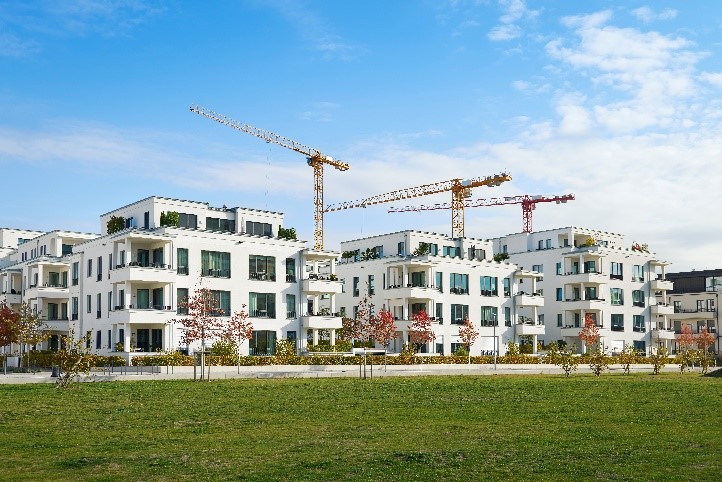In the current economic landscape, multi-family investors are grappling with tightening credit standards and weaker loan demand due to the Federal Reserve’s interest-rate hike campaign. These trends will likely persist throughout 2023 as banks foresee further tightening lending standards. While these credit conditions raise concerns about a potential economic slowdown, the multi-family market remains resilient. Despite a modest uptick in vacancy rates, net absorption of units has increased, suggesting a recovery in rental demand. The sector’s average monthly net effective rent continues to grow, and new construction deliveries have reached record highs. Certain regions, like the Northeast/Mid-Atlantic, Midwest, and Southeast, stand out with positive net absorption and rent growth. However, rising insurance costs pose challenges for investors and developers, leading some to consider selling properties. These rising costs affect housing affordability, especially for low-income households. High net worth investors favor multi-family and industrial real estate segments due to strong demand for affordable housing and risk-adjusted returns. Despite emerging niche asset classes, multi-family and industrial properties maintain their popularity. Investors prefer primary and secondary markets while remaining cautious about the office segment due to ongoing challenges.
Multi-family Investors Face Tightening Credit and Weaker Loan Demand Amidst Economic Trends

Further Tightening & Lending Standards in 2023
In recent reports, U.S. banks have disclosed tighter credit standards and weaker loan demand for businesses and consumers during Q2, influenced by the Federal Reserve’s ongoing interest-rate hike campaign. The Fed’s Senior Loan Officer Opinion Survey indicates that banks anticipate further tightening in lending standards throughout 2023. Factors leading to tightening lending standards include a less favorable economic outlook, expected deterioration in collateral values, and potential credit quality declines in commercial real estate and other loans.
Rising Concerns of Potential Economic Slowdown
The tightening credit conditions may be significant by historical standards, raising concerns about a potential economic slowdown, although it does not necessarily predict an imminent recession. Despite the slowdown, the report does not show an urgent need for rapid tightening as previously feared after the banking turmoil in March.
Multi-family & Industrial Report Lowest Delinquency Rates
The multi-family sector is also witnessing its share of challenges. According to a recent Trepp report analyzing bank balance sheet loan data, total commercial real estate (CRE) mortgage delinquencies have risen, with the highest rates observed in the lodging and retail sectors. In contrast, multi-family and industrial properties reported the lowest delinquency rates.
Multi-family Market Remains Resilient
Despite the economic uncertainties and tightening of credit, the multi-family market has remained relatively resilient. Multi-family investors should carefully monitor credit conditions and loan demand trends while considering opportunities in regions with more favorable risk outlooks.
Multi-family Market Stabilizes with Strong Absorption and Gradual Vacancy Recovery

Multi-family Sector Navigates Complexities of 2023
As the multi-family sector navigates the complexities of 2023, recent research indicates that the U.S. apartment market is showing signs of stabilization. The second quarter of 2023 witnessed a modest uptick in vacancy rates, rising by ten basis points to 5.0%. However, this increase is slower than in previous quarters, signifying a positive trend. A notable highlight is the substantial net absorption of 70,200 units in Q2 2023, the highest since Q1 2022, suggesting a recovery in renter demand.
Multi-family Market Still Performing Relatively Well
The average monthly net effective rent demonstrated steady growth, increasing by 2.6% year-over-year, aligning with pre-pandemic averages. This indicates that the multi-family market is still performing relatively well despite economic challenges. Furthermore, new construction deliveries reached a record high of 91,400 units in Q2 2023, contributing to the four-quarter total of 351,500 units. However, fewer new deliveries are expected in 2024 and beyond, as construction starts have declined recently.
Certain Regions Stand Out
While most markets are experiencing positive net absorption and rent growth, specific regions stand out. The Northeast/Mid-Atlantic region leads with the highest year-over-year rent growth, followed by the Midwest and the Southeast. Significant markets such as New York, Washington, D.C., Dallas, Orlando, and Phoenix accounted for a significant portion of the national total for new apartment deliveries in the past four quarters.
Pipeline for New Construction Remains High
As the multi-family market continues to evolve, Yardi Matrix provides a supply forecast, projecting increased completions in 2023 and 2024. The forecast considers the Federal Reserve’s interest rate hikes, anticipating a mild recession starting late in 2023 or early 2024. The forecast indicates that Austin will lead in the volume of new supply, with more units expected to be completed in 2023 and 2024. The pipeline for new construction remains high, with 1,118,046 new apartments currently under construction.
Careful Consideration & Changing Dynamics
The multi-family market is resilient amidst economic challenges and continued supply growth. As investors and industry participants closely monitor market trends, careful consideration of the changing dynamics will be vital for making informed decisions. The multi-family sector continues to offer investment opportunities, but diligent analysis and adaptability will be vital to navigating the changing market landscape.
Rising Insurance Costs Pose Challenges for Multi-family Investors and Developers

Owners Facing Significant Increase in Some Expenses
The multi-family industry faces complex financial challenges in 2023, with rising insurance costs adding to the strain on apartment owners and developers. As rents stabilize, property owners are experiencing significant increases in various expenses, including property taxes, utilities, and labor costs. However, the soaring cost of insurance, which has surged by over 100% in some states, is emerging as a particularly worrisome issue.
Rise in Insurance Premiums Prompt Some Owners to Consider Selling
The sharp rise in insurance premiums has prompted some apartment owners to consider selling their properties or, at the very least, contemplate the sale as a potential option. The burden of exorbitant insurance prices and escalating variable rate debt and property taxes are making it increasingly difficult for apartment owners to maintain profitable operations.
Forced Sales and Challenges for Transactions
The surge in insurance costs has led some owners to hand over their properties to banks while others are forced to sell, even though this is only sometimes a straightforward solution. The increased insurance pricing is creating challenges for underwriting transactions and new developments. Some apartment owners have already experienced deals falling through because buyers find it difficult to obtain suitable coverage at a reasonable cost.
The Impact on New Developments
Developers are also facing obstacles in underwriting new deals. Rising material, labor, and land costs and higher insurance expenses have made it increasingly difficult to make new developments financially viable. The rise in insurance costs has contributed to stalled developments, negatively impacting the availability of moderately priced housing.
Affordable Housing Affected
Affordable housing developers are also grappling with the consequences of escalating insurance prices. The increasing costs put affordable housing projects at risk, making it nearly impossible to create new housing units to address the nation’s housing affordability crisis.
Seeking Solutions to Rising Insurance Costs
Apartment executives respond to these cost pressures by adopting various strategies, such as shopping for better insurance deals, collaborating with brokers, and considering self-insurance. Flexibility from lenders and potential government-led reforms could provide some relief. However, the industry needs to develop adequate solutions to mitigate the effects of rising insurance costs on housing affordability.
Outlook for Multi-family Permits and Starts
In addition to insurance concerns, the multi-family sector is experiencing a slowdown in permitting and starts. As of June, both multi-family permitting and starts saw monthly and annual declines. The rate for multi-family permitting dropped by 13.5% from May to 467,000 units, representing a 33.1% decrease from the previous year. Multi-family starts also experienced a decline of 11.6% from May to June, down 11.3% year-over-year.
Investors & Developers Must Remain Vigilant
As the multi-family industry navigates these challenges, investors and developers must remain vigilant and adaptable to changes in the market landscape. Seeking creative solutions and exploring potential partnerships will be crucial to sustaining growth and addressing the evolving needs of the housing market.
High Net Worth Investors Favor Multi-family and Industrial Real Estate Segments

High Net Worth Investors Show Strong Preference for Multi-family
High net worth investors (HNWI) strongly prefer multi-family and industrial assets when investing in commercial real estate. A recent survey conducted by WMRE and WealthManagement.com, in partnership with Ashcroft Capital, sheds light on the investment strategies of accredited investors and provides valuable insights for commercial real estate professionals and financial advisors.
Top Preferences: Multi-family and Industrial
The survey reveals that multi-family and industrial properties remain the top choices among HNWIs for commercial real estate investments. While financial advisors and commercial real estate professionals agree on the preference for these segments, the latter group demonstrates a stronger conviction. Approximately 70% of commercial real estate professionals believe HNWIs favor multi-family, while 64% prefer industrial. Among financial advisors, 48% cited multi-family as the top choice, followed by industrial at 36%. Self-storage emerged as the third most attractive segment, garnering interest from 40% of financial advisors and 35% of real estate professionals.
Shift in Office Segment Sentiment
Respondents display a more pessimistic view of the office segment. Only 18% of financial advisors and 9% of commercial real estate professionals believe HNW investors prefer office properties. This sentiment aligns with the challenges the office sector has faced during and after the pandemic, contributing to a steady downward trend in interest.
Multi-family s Enduring Appeal
Experts attribute the continued popularity of multi-family properties to the high demand for affordable housing in the U.S. A significant housing supply deficit has persisted for over two decades, emphasizing the need for rental accommodations. Investors recognize the essential supply and demand dynamics and the fundamental reality that everyone needs a place to live. With an affordability gap between renting and owning, national rents remain at around $1,700 per month, making multi-family properties an attractive investment.
Emerging Niche Asset Classes
While traditional property types like multi-family and industrial continue to dominate, niche asset classes are gaining interest among investors. Segments like single-family rentals, manufactured housing, student housing, and healthcare properties are becoming more institutionalized and are perceived as providing diversity and risk-adjusted returns. For instance, student housing, being countercyclical, presents unique opportunities.
Market Preferences: Primary and Secondary Markets
The survey shows that HNWIs prefer primary and secondary markets for their investment endeavors. Most financial advisors (81%) and real estate professionals (80%) believe HNWIs strongly prefer primary and secondary markets. In contrast, tertiary markets garner less interest, with only 47% of respondents seeing an inclination toward these markets. Investors are focused on migration trends and are cautious about the exit strategy, leading to a more conservative approach to tertiary markets.
Multi-family Offers Enduring Appeal
The survey findings demonstrate that HNWIs prefer multi-family and industrial real estate segments. The enduring appeal of multi-family properties can be attributed to the persisting demand for affordable housing. Moreover, the survey highlights the emerging interest in niche asset classes and the cautious approach toward the office segment. Investors’ focus on primary and secondary markets underscores the importance of migration trends and exit strategies. Financial advisors and commercial real estate professionals must understand these investment preferences to offer tailored strategies that align with HNWI goals and market trends.


